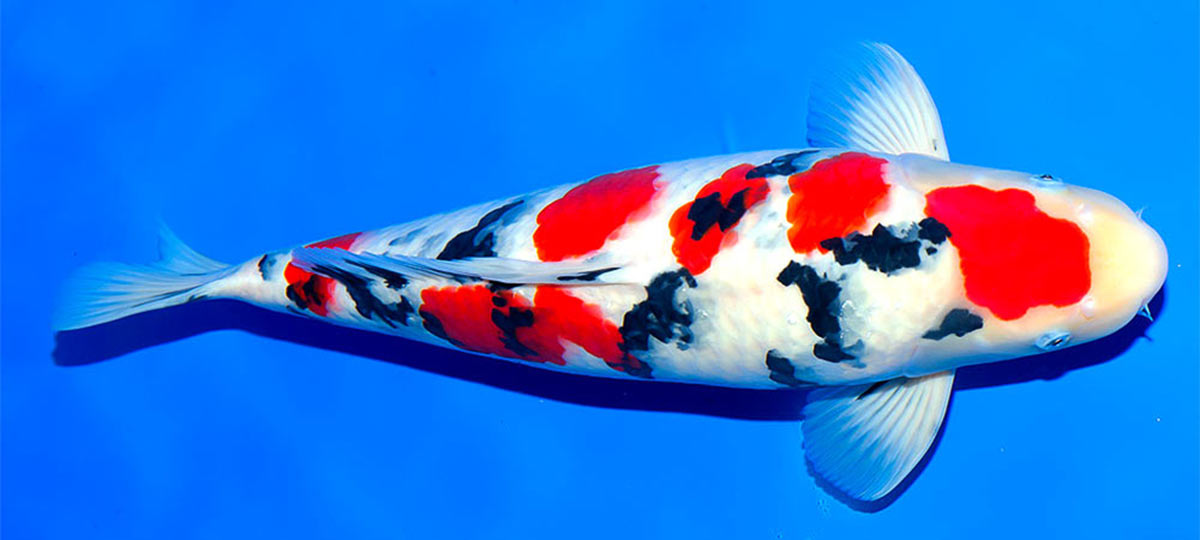Taisho Sanke, commonly called Sanke, are basically a Kohaku with added black markings or sumi. In fact, they are closely related to Kohaku. Koi with black markings began to appear in the spawn of Kohaku in the early 1900’s. This inspired Eizburo Hoshino to cross one of these parent Kohaku with a Shiro Bekko (a white koi with black markings). The resulting fry showed great promise, as they had the typical Sanke colours in fairly equal proportions, and a new variety was created. However, it was Torakichi Kawikame who ‘fixed’ the strain (making it stable for breeding) and the resulting bloodline became known as the Torazo bloodline. All current sanke bloodlines have arisen from the Torazo or Sanba (now extinct) bloodlines.

Sanke were the first tricolour (white, red and black) koi variety to be developed. It is the second in the group of koi known as the ‘Big Three’ (Kohaku, Sanke & Showa) also known as Gosanke. They are white koi with large patterns of hi (red) and smaller sumi (black marking) evenly distributed on the body.
As with Kohaku, the white should be snow-white and lustrous, and the red markings (hi) should be deep in colour with the edges of the pattern well defined. The sumi should be deep black, though it usually appears as light blue or grey in young koi, before it fully develops. The sumi should also be distributed evenly throughout the body to provide a pleasing pattern. While sumi may develop on the hi (red) or on the white skin, Sanke with sumi on the white are highly sought after.
Sanke usually only have the sumi on the upper half of the body, they typically shouldn’t have any below the lateral line. This is one major feature that distinguishes Sanke from Showa, whose sumi are usually much larger and extend right down to the belly. Sanke often have some black stripes on the pectoral fins, but should not have motoguro – a block of black at the base of the pectoral fin.
Another characteristic that differentiates Sanke from Showa, is that Sanke do not usually have any sumi on the head. While classic Sanke will have only red over white on the head, quality Showa will always have a significant amount of black on the head.
Below you will see some high quality Sanke koi. These are koi that are produced by some of the best breeders in Japan.
Below you will see a video of some beautiful nisai (2 year old) sanke.
Below you will find the descriptions, terminology and phrases commonly used to describe Sanke koi.
Aka – (AH kah) Red
Aka Sanke (AH kah SAHN keh) A sanke with large areas of hi (red) without breaks in the pattern
Aka hana – (AH kah HAH nah) Red nose
Bozu – (boh ZOO) No hi on the head, bald head
Ginrin or Gin-Rin – (geen reen) Refers to sparkling scales
Hachi – (HAH chee) Head
Hara – (hah RAH) Abdominal area
Hi – (HEE) A term for red
Ippon hi – (EE pohn HEE) A continuous red pattern from head to tail
Kasane sumi – (KAH sah neh SOO mee) A black marking (sumi) on a red pattern
Kuchibeni – (KOO chee BEN eee) Red lips
Menkaburi – (MEHN kah BOO ree) Hi (red) covering the entire face or head
Motoaka – (MOH toh AH kah) Red markings at the base of the pectoral fins
Motoguro – (MOH toh GOO roh) Black markings at the base of the pectoral fins
Nezu – (NEH zoo) Light Grey
Odome – (oh DOH meh) Last marking before the tail
Ojime – (oh GEE meh) Gap between the last pattern marking and the tail
Sanke – (SAHN keh) A white koi with hi (red) and sumi (black) patterns
Shiro – (SHEE roh) White
Sumi – (SOO mee) Black
Tancho sanke – (TAHN choh) A sanke with a single hi (red) spot on the head and typical markings on the body
Tsubo sumi – (TSOO boh SOO mee) Black pattern (sumi) over white skin
Back to our Koi Varieties Guide